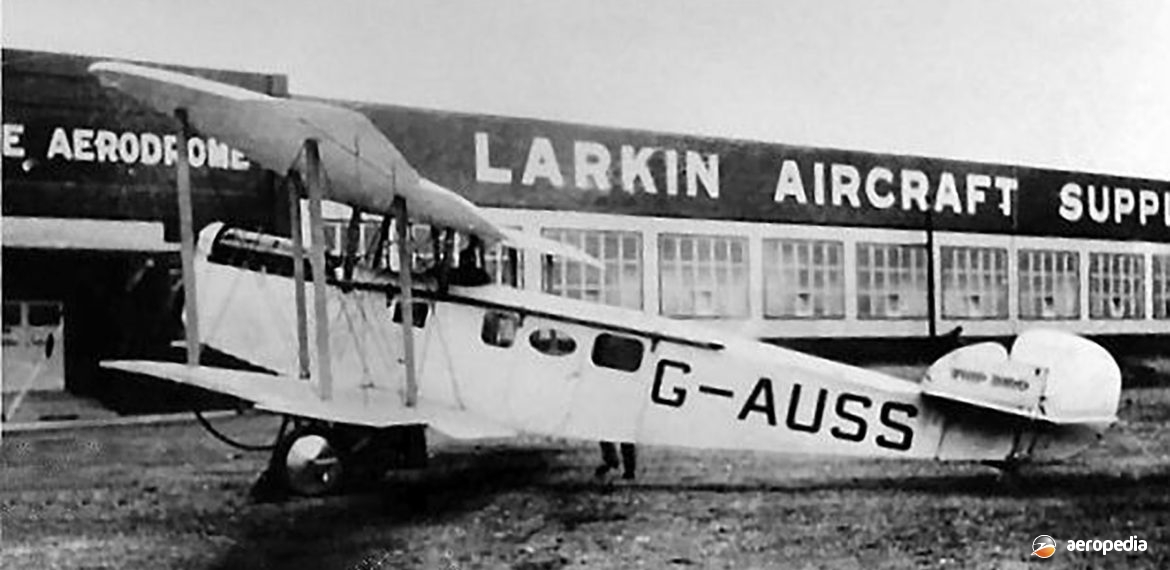Photograph:
Sopwith Antelope G-AUSS c/n 3398) at Coode Island, VIC (Eddie Coates Collection)
Country of origin:
United Kingdom
Description:
Commercial transport
Power Plant:
One 149 kw (200 hp) Wolseley Viper eight-cylinder VEE liquid-cooled engine
Specifications:
- Wingspan: 14.17 m (46 ft 6 in)
- Length: 9.44 m (31 ft)
- Max speed: 178 km/h (110 mph)
- Cruising speed: 135 km/h (84 mph)
- Empty weight: 1,083 kg (2,387 lb)
- Loaded weight: 1,565 kg (3,450 lb)
History:
In 1920 the British Air Ministry published rules for a Small Commercial Aeroplane Competition and a number of designs were entered, including the Westland Limousine and the Sopwith Antelope. The former won the competition and entered production, the Antelope coming second, being flown during the competition by Australian-born Harry Hawker.
The Antelope was designed to carry two passengers in an enclosed cabin behind the pilot’s open cockpit. Built at Kingston-on-Thames in 1919, only one machine was completed. This machine (G-EASS – c/n W/O 3398) was initially fitted with a four-wheel main undercarriage, the wheels having brakes. Power plant was a Wolseley Viper eight-cylinder unit, this being a modified Hispano Suiza engine. On 5 June 1922, whilst flown by F P Raynham, it won the Surrey Open Handicap Race at Croydon before being imported to Australia for the Larkin-Sopwith Aviation Co, as it was then known, being registered in Australia on 18 April 1923 to the Larkin Aircraft Supply Co Ltd of Melbourne, VIC and named Whip Bird.
In 1921 the decision was made to set up aerial mail services from Adelaide to Sydney, Sydney to Brisbane, Melbourne to Tasmania, and Cloncurry to Charleville, the Government to provide subsidies to the companies chosen to perform these services. Tenders were entered, amongst others, by Larkin Aircraft Supply Co Ltd, this tender being accepted for the Sydney to Adelaide route; and that of F L Roberts for the Sydney to Brisbane Route.
In 1922 Australian Air Mail Services took over these routes. One of the aeroplane types ordered to perform this work was the Handasyde H.2. However, deliveries of this type of machine were delayed and LASCo (as it had become known) indicated to the Government it had the Antelope (G-AUSS – c/n 3398 – ex G-EASS) with a spare engine in Melbourne available to operate the services, along with the company’s three de Havilland DH.50s and a Sopwith Wallaby. The fleet also included an Airco DH.4.
After assembly in Melbourne the Antelope was used on the aerial mail services, being flown to Hay, NSW the main operating base. Initially, after servicing, it was flown to Mildura, VIC to pick up mail and then flown towards Sydney, NSW. However, over Campbelltown, NSW the engine failed and it made a forced landing.
In 1926 the Antelope had its engine replaced by a 179 kw (240 hp) Siddeley Puma. It is interesting to note when built, as noted above, it had a four-wheel main undercarriage but photographs indicate at some stage this was changed to single wheels. During the whole of its life the machine was registered to Australian Aerial Services Ltd or Larkin Aircraft Supply Co, which basically were one and the same entity. On 31 August 1930 it became VH-USS and on 9 June 1933 the Certificate of Registration lapsed. It was renewed on 28 February 1934 but the machine was withdrawn from service on 27 February 1935.

